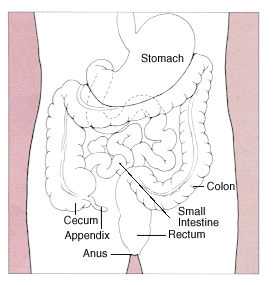Appendix (anatomy): Difference between revisions
→Function: rmv unverifiable "fact" |
→Function: Restored last paragraph (see talk page). |
||
| (One intermediate revision by one other user not shown) | |||
| Line 12: | Line 12: | ||
Another explanation is that the appendix is a remnant of an earlier function, with no current purpose. Note, however, that the [[pineal gland]], which only recently (around 1960) was found to produce important chemicals like [[melatonin]], was once considered a vestigial remnant, as well. |
Another explanation is that the appendix is a remnant of an earlier function, with no current purpose. Note, however, that the [[pineal gland]], which only recently (around 1960) was found to produce important chemicals like [[melatonin]], was once considered a vestigial remnant, as well. |
||
Another explanation is the human appendix may serve a purpose in a diet including occasional raw meat. Specifically, it may allow bacteria useful in the digestion of raw meat to be retained, rather than flushed from the system during long intervals between raw meat meals. Thus, those lacking an appendix may be less able to digest raw meat than others. However, as raw meat is no longer a significant portion of most people's diets, this difference would be difficult to detect. An experiment could be devised where a control group with appendices and an experimental group without were both fed occasional raw meat diets, of a type similar to what prehistoric humans likely encountered prior to their mastery of fire for cooking. |
|||
==Diseases== |
==Diseases== |
||
| Line 42: | Line 44: | ||
[[ja:虫垂]] |
[[ja:虫垂]] |
||
[[ms:Apendiks]] |
[[ms:Apendiks]] |
||
[[pt:Apêndice vermiforme]] |
|||
[[nl:Wormvormig aanhangsel]] |
[[nl:Wormvormig aanhangsel]] |
||
[[pl:Wyrostek robaczkowy]] |
[[pl:Wyrostek robaczkowy]] |
||
Revision as of 05:36, 14 June 2006


In human anatomy, the vermiform appendix (or appendix, pl. appendixes or "appendices") is a blind ended tube connected to the cecum ('caecum' in British English). It develops embryologically from the cecum.
Size and location
The appendix averages 10 cm in length, but can range from 2-20 cm. The diameter of the appendix is usually less than 7-8 mm. The longest appendix ever removed was that of a Pakistani man on June 11, 2003, at Pakistan Institute of Medical Sciences, Islamabad, Pakistan, measuring 23.5 cm (9.2 in) in length. [1]
While the base of the appendix is at a fairly constant location, the location of the tip of the appendix can vary from being retrocaecal to being in the pelvis to being extraperitoneal. In most people, the appendix is located at the lower right quadrant of the abdomen. In people with situs inversus, the appendix may be located in the lower left side.
Function
Currently, the function of the appendix, if any, remains controversial in the field of human physiology. The wall of the appendix contains lymphatic tissue that may be part of the immune system for making antibodies. There have been cases of people who have been found, usually on laparoscopy or laparotomy, to have a congenital absence of their appendix. There have been no reports of impaired immune or gastrointestinal function in these people.
Another explanation is that the appendix is a remnant of an earlier function, with no current purpose. Note, however, that the pineal gland, which only recently (around 1960) was found to produce important chemicals like melatonin, was once considered a vestigial remnant, as well.
Another explanation is the human appendix may serve a purpose in a diet including occasional raw meat. Specifically, it may allow bacteria useful in the digestion of raw meat to be retained, rather than flushed from the system during long intervals between raw meat meals. Thus, those lacking an appendix may be less able to digest raw meat than others. However, as raw meat is no longer a significant portion of most people's diets, this difference would be difficult to detect. An experiment could be devised where a control group with appendices and an experimental group without were both fed occasional raw meat diets, of a type similar to what prehistoric humans likely encountered prior to their mastery of fire for cooking.
Diseases
The most common diseases of the appendix (in humans) are appendicitis and carcinoid.
An operation to remove the appendix is an appendicectomy (also appendectomy).
References
External links
- "The vestigiality of the human vermiform appendix: A Modern Reappraisal" -- evolutionary biology argument that the appendix is vestigial
- A professor of physiology claims the appendix has a known function
